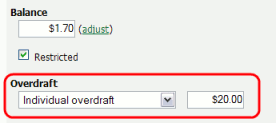The overdraft setting applies to restricted users (and restricted Shared Accounts). An overdraft allows a user to continue to use services even though their account has dropped below zero. In essence, the overdraft value moves the "zero-point" allowing users to overdraw the account to the agreed limit. An overdraft can also be referred to as a credit limit.
Reasons for using an overdraft include:
Provide users with flexibility between budget, quote or allocation periods. For example, an overdraft will allow a user to "draw on" a portion the next month's quota allocation.
To Implement a credit system with credit limits rather than an up-front pay system.
Grant trusted users a "loan" on a case-by-case basis.
An overdraft can be defined at two levels:
Globally as a default affecting all users and shared accounts.
On an individual user or account basis.
The default overdraft is zero. This can be changed by → → →
Optionally, a separate overdraft can be applied to an individual user (or shared account) using the following procedure:
Click on the Users section.
Select the user.
Ensure the account is set as Restricted.
In the Overdraft field, select the option Individual overdraft.
Enter a positive value in the adjacent overdraft balance field.
Click to save the changes.
